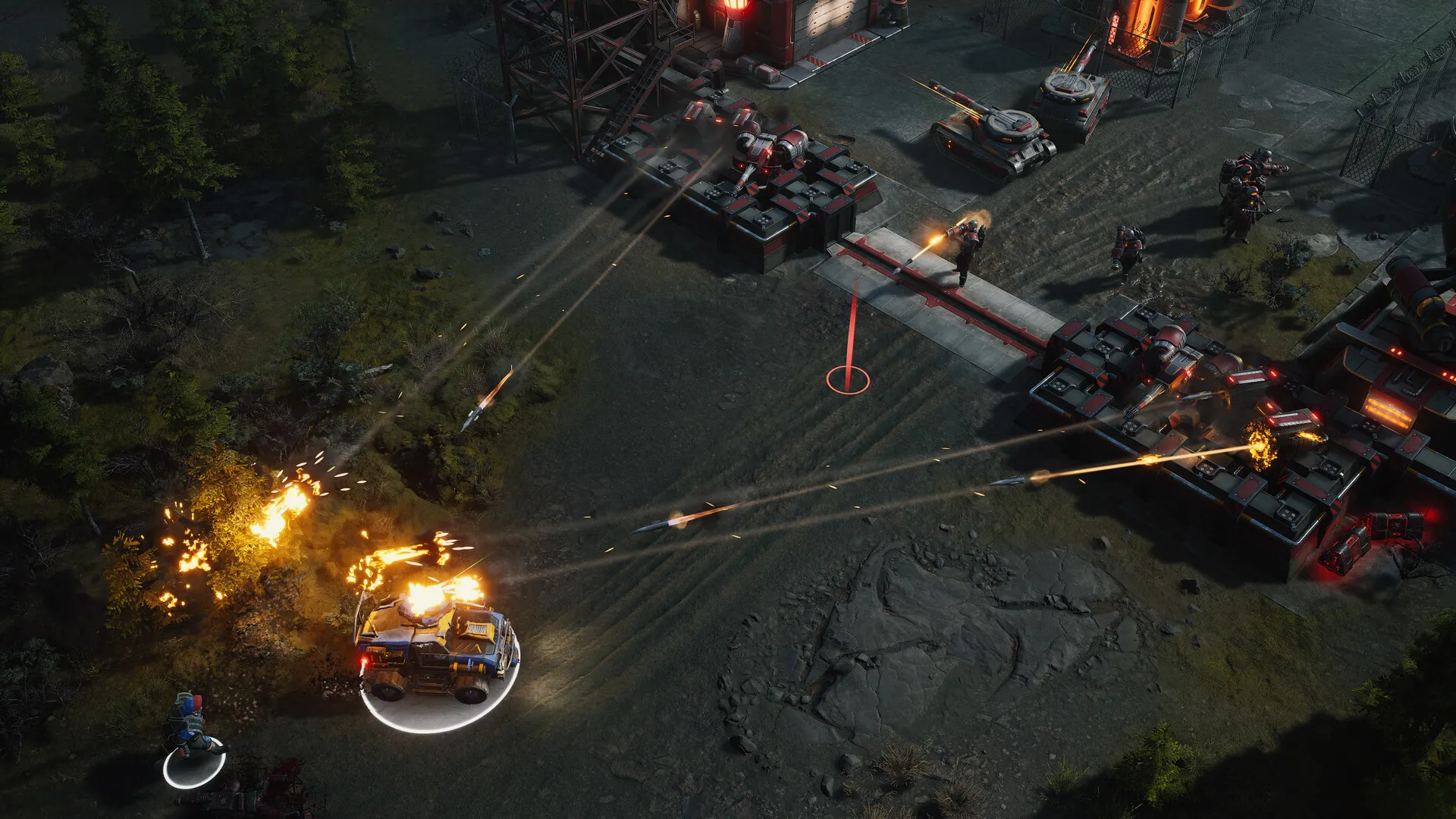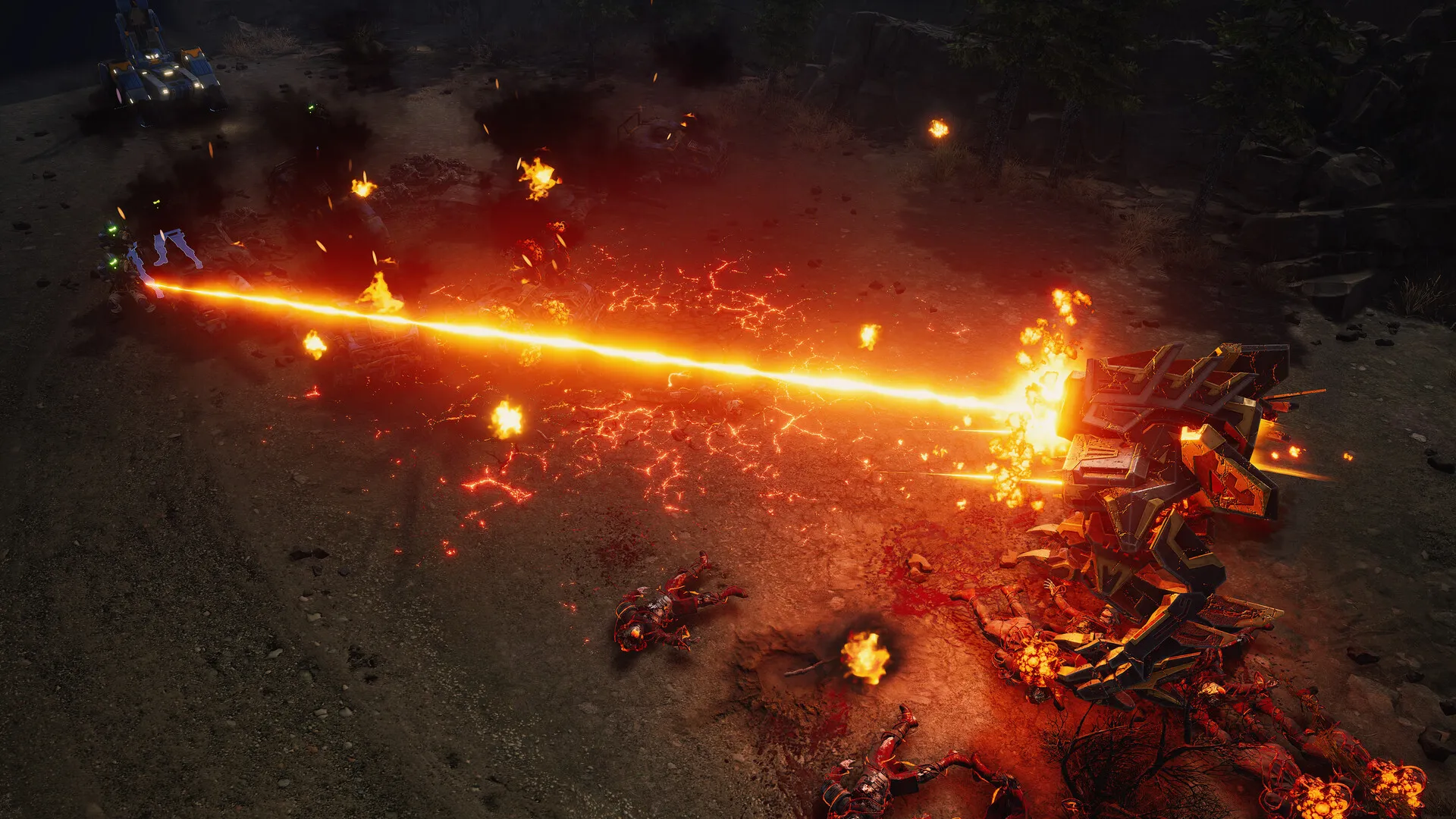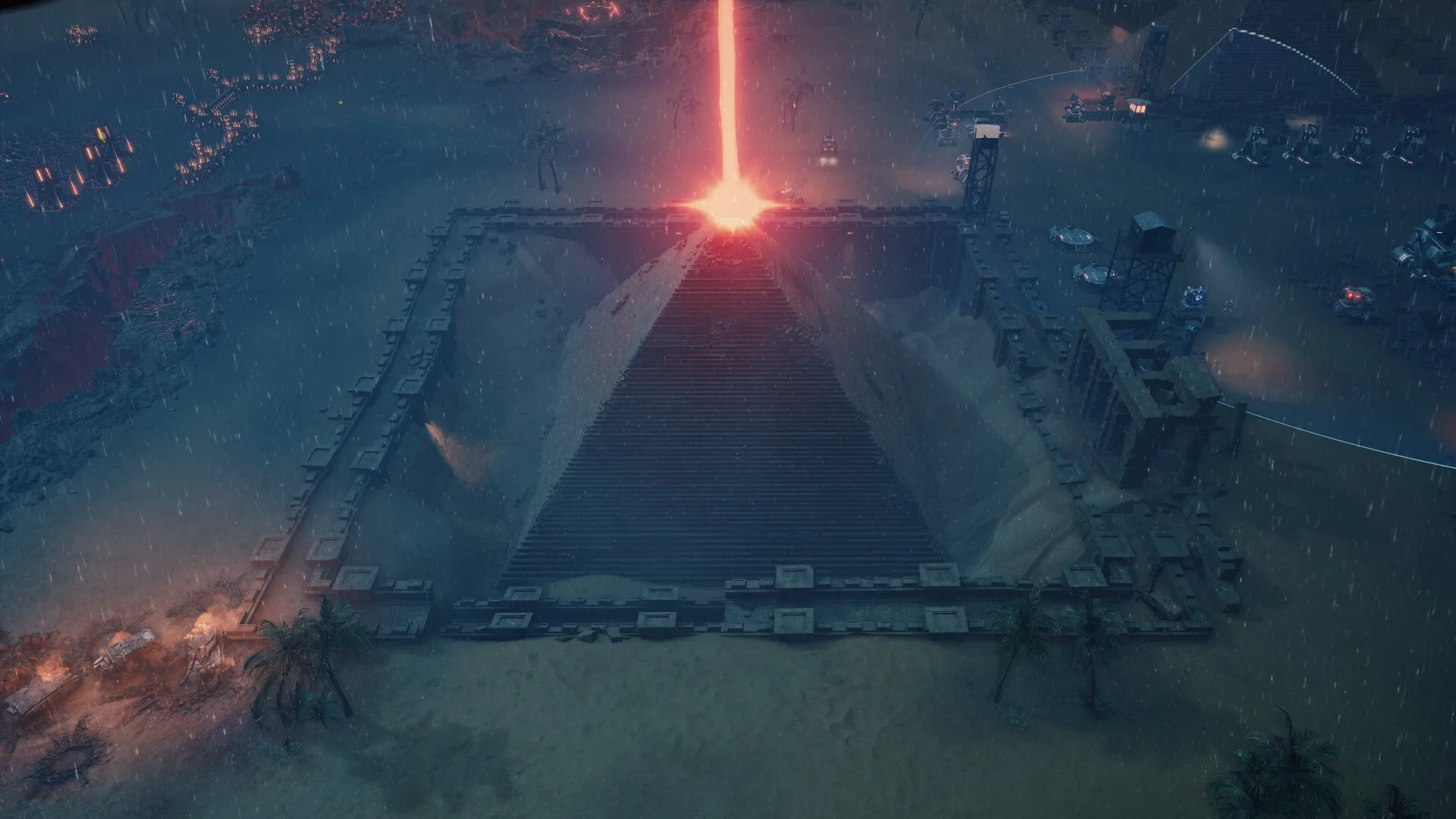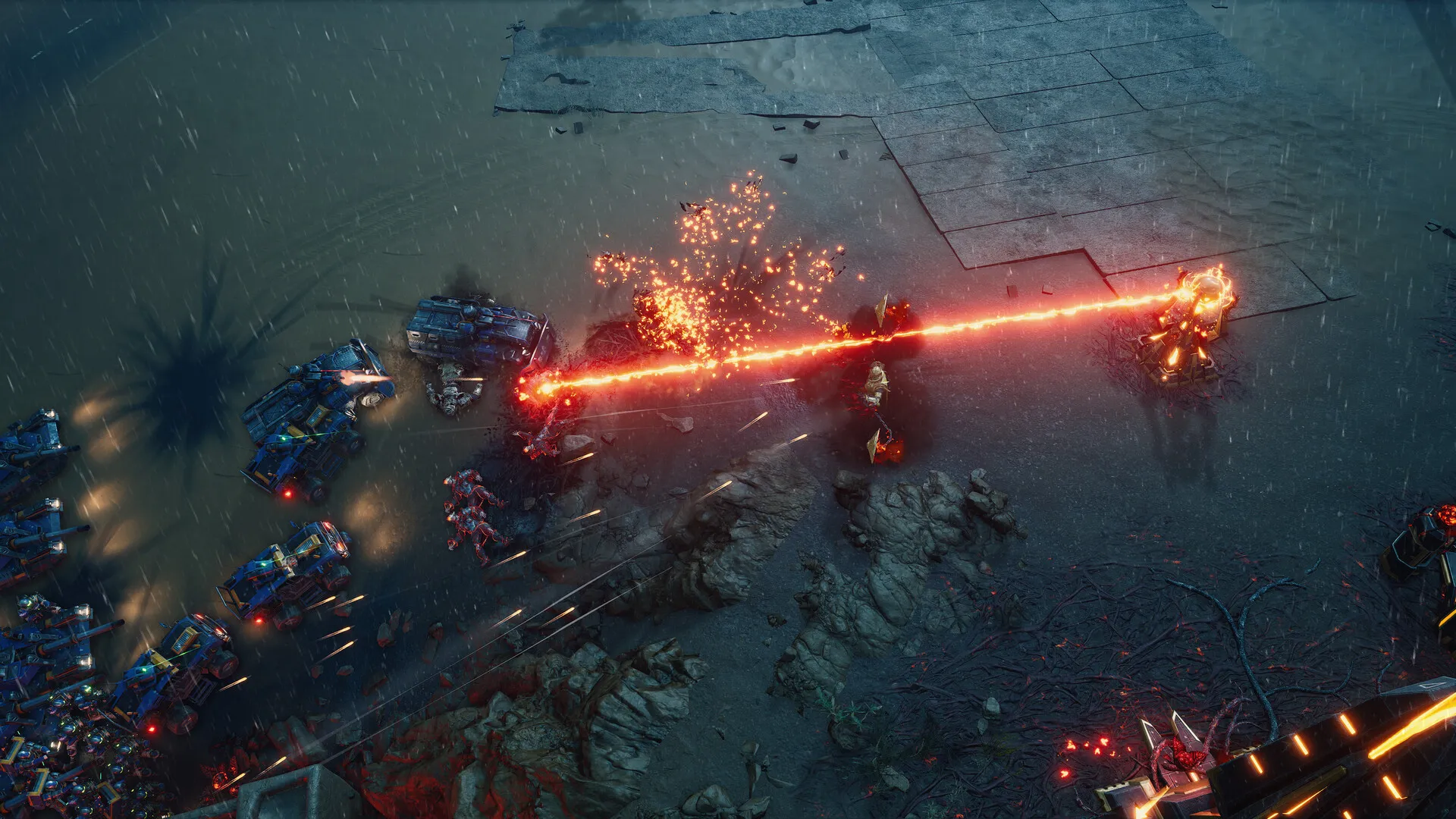Slipgate Ironworks’ Tempest Rising arrives with a clear mission: revive the high-octane real-time strategy gameplay of the mid-1990s. From its synth-metal soundtrack that echoes Red Alert’s thunderous riffs to its thinly veiled faction parallels, the game wears its inspirations on its sleeve while striving to sharpen those familiar mechanics for today’s audience.
Set in 1997 after a catastrophic third World War, humanity grapples with “Tempest,” a sprawling, flower-like growth that poisons the environment even as it promises nearly limitless energy. Your role is to harness this double-edged resource, forging an army and infrastructure that will tip the global balance of power.
You’ll command one of two rival forces: the technologically advanced Global Defense Force, whose drone-assisted infantry and blueprint-driven construction lend a methodical edge, or the Tempest Dynasty, whose mobile harvest rigs, instant-build structures, and devastating sphere-rolling behemoths favor aggressive expansion. Both sides share the familiar RTS ritual of harvesting resources, erecting bases, training units, and laying waste to enemy fortresses—yet the ways you achieve those goals feel refreshingly distinct.
Behind its throwback façade, Tempest Rising integrates modern conveniences: hit TAB to cycle unit abilities, hold ALT to synchronize movement across mixed squads, and enjoy a clean, customizable HUD. These additions keep the action flowing without sacrificing the genre’s signature intensity.
Story & Setting
From its Cold War–tinged premise to its alien menace, Tempest Rising builds a world that feels both familiar and unnerving. The campaign opens in 1997, following a Cuban Missile Crisis that spiraled into all-out nuclear conflict. In the war’s aftermath, a strange russet growth dubbed “Tempest” spreads across the globe—its toxic blooms poisoning ecosystems even as its crystalline cores promise near-limitless energy.
Two factions vie for control of this resource. The Global Defense Force represents the last vestiges of Western military coalitions, prioritizing order, reconnaissance, and surgical strikes. By contrast, the Tempest Dynasty unites former Soviet and Asian powers under a fervent paramilitary banner, favoring aggressive expansion, guerrilla ambushes, and raw firepower. Their ideological clash echoes the GDI versus Nod dichotomy from Command & Conquer, yet each side’s distinct economy and build mechanics give the struggle fresh tactical wrinkles.
The dual-campaign structure lets you experience major events from both perspectives. Between missions, a strategic map of Europe and North Africa illustrates shifting borders as bases rise and fall, creating a real sense of territorial tug-of-war. Just as StarCraft II introduced switching viewpoints in its Heart of the Swarm expansion, Tempest Rising uses interludes to connect narrative beats and emphasize how battlefield decisions ripple across continents.
Late in the campaign, an unexpected third player emerges: the Veti. These technologically advanced outsiders inject new tension into the climax, forcing both main factions to adapt or face annihilation.
Visually and tonally, the game strikes a balance between gritty military realism and sci-fi spectacle. Briefing cinematics employ stylized 3D avatars rather than old-school FMVs, which streamlines storytelling while trading away some retro charm.
Distinct Factions and Tactical Diversity
Tempest Rising hinges on its asymmetric design, with each side offering a markedly different toolkit. From how you gather Tempest to the way structures go up and units deploy, the Global Defense Force and Tempest Dynasty demand unique approaches. Mastering their contrasts—and later adapting to the enigmatic Veti—becomes a central part of the strategic puzzle.
The GDF’s resource model relies on a stationary refinery fed by dump trucks, which forces you to protect chokepoints around fixed harvest sites. Construction feels deliberate: you place blueprints on the ground, then wait through vulnerable build times—recalling the cautious base expansion in StarCraft’s Terran play.
Its standout units include the Trebuchet, a heavy tank that transforms into a long-range artillery cannon almost instantly, and the Shieldmaiden hovercraft, whose gatling laser handles enemy aircraft while its repair capsule keeps nearby allies fighting longer. Support comes from drone-pilot infantry, which launch micromissiles at armored targets, and scout 4x4s that mark foes to boost allied damage—an intel-driven twist on classic recon roles.
Dynasty harvesting is mobile and aggressive: wheeled rigs unfold into clusters of bots that both gather Tempest and swarm defense points. Its build menu queues structures that appear instantly, impervious to construction fire, echoing the rapid base setups of classic Command & Conquer’s Brotherhood of Nod.
Flaming infantry clear swaths, cluster-missile SUVs rain fragmentation on groups, and mobile rocket trucks punch through armor. The showstopper is the crushing metal sphere, a rolling behemoth that flattens infantry and light vehicles alike. The Salvage Van doubles as a portable HQ with an aura that repairs buildings and units, encouraging forward outposts and map control.
Introduced late in the campaign, the Veti hint at heavy armor and energy-based weapons that neither GDF nor Dynasty can replicate. Though they’re unavailable in skirmish or multiplayer yet, early missions showcase their brute-force tanks and shielded infantry, setting the stage for fresh strategies down the line.
Each faction fields specialists—like a stealth sniper for precise eliminations or a machinist who detects cloaked units—and faction-wide abilities such as GDF airstrikes or Dynasty salvage deployments. Smart players chain these tools for lightning raids: mark a distant base with scouts, sneak in the sniper, then call down a precision strike. Conversely, heavy repair units counter firepower spikes by keeping armies alive through extended engagements. This push-and-pull of intel versus raw force gives Tempest Rising its tactical depth.
Core Gameplay Mechanics
Resource management in Tempest Rising hinges on controlling map-based Tempest nodes and optimizing harvesting rates. The Dynasty’s mobile rigs unfold into clusters of bot harvesters, allowing you to sweep through fields quickly, whereas the GDF’s stationary refineries demand secure chokepoints around their dump-truck feeders. This contrast turns every resource skirmish into a tactical choice: do you spread Dynasty harvesters across multiple small deposits or fortify a few high-yield sites with GDF defenses?
Base-building excels on similar asymmetry. GDF structures begin as vulnerable blueprints that can be shelled before completion, echoing the risk–reward tension found in StarCraft’s Terran builds. The Dynasty, by contrast, queues buildings in a menu and plops them down fully formed, invulnerable during assembly.
Both sides leverage forward outposts—GDF beacons create temporary build zones almost anywhere, while Dynasty salvage vans double as portable HQs with repair auras. Mapping terrain matters: high ground offers firing advantages, narrow passes become defensive strongholds, and open plains favor rapid expansion.
Unit production follows a classic tech-tree progression through central hubs—Construction Yards for GDF, Command Centers for Dynasty. Between missions, you choose global upgrades such as stolen blueprints to unlock enemy tanks or veterancy bonuses that boost starting unit levels. These meta-choices reward replayability, much like the persistent upgrades in Company of Heroes.
In combat, active unit abilities add a layer of micromanagement. Repair capsules from Shieldmaidens, stealth cloaks for sniper specialists, and deployable turrets from salvage vans all hinge on timely activation. Modern conveniences—TAB cycling through highlighted abilities and ALT-synchronized movement—keep hotkey-driven control groups efficient, letting you juggle frontline assaults with precision.
Territory control revolves around tempest fields and landmarks. Claiming them not only increases resource income but also provides forward staging points for deeper incursions, especially when backed by a mobile HQ.
A polished UI rounds out the experience: clear tooltips detail ability cooldowns, health bars show armor variances, and minimap alerts flag incoming attacks and mission timers. Every element is designed to keep the player informed and engaged, ensuring that strategic decisions remain at the forefront of the battlefield.
Campaign Structure & Mission Design
Slipgate Ironworks lays out dual eleven-mission campaigns that ease you into Tempest Rising’s mechanics before ramping up pressure. Playing through one faction teaches core systems—harvesting, base defense, unit abilities—then flips perspective so you can apply that knowledge with a different toolkit. This parallel storytelling converges in a shared finale, echoing the mirrored narratives of StarCraft II’s Wings of Liberty and Heart of the Swarm.
Mission variety keeps each playthrough engaging. Early objectives send you on convoy interceptions with strict time windows, requiring map control and quick strikes. Defense holdouts force you to strengthen chokepoints against waves of enemies, while specialist-led stealth or sniper tasks demand careful positioning and patience. Dynasty’s mid-campaign mission to defend multiple bases under Tempest harvesting quotas tests resource juggling and split forces, blending base management with tactical defense.
The difficulty curve strikes a deliberate balance. Initial missions function as interactive tutorials; by the fifth GDF scenario, you’re clearing multiple zones before a nuclear-tipped convoy arrives on a schedule. Optional secondary goals—like capturing hidden outposts—reward replays with bonus upgrades or veterancy slots. Mid-mission timers and scripted enemy movements drive urgency, much like the countdown objectives in the later missions of Command & Conquer 3.
Between battles, briefing sequences use crisp animated avatars to outline objectives. Their efficiency keeps pacing tight, though they lack the over-the-top personality of live-action FMVs from 90s RTS classics. Mission titles such as “Pull That Base Apart” capture the tone without overstaying their welcome.
Late in the campaign, the Veti materialize as a faction neither side can ignore. Their arrival reshapes objectives—introducing energy-shielded behemoths and alien infantry that force you to rethink veteran strategies and unit compositions. This narrative twist brings fresh tactics to the climax, reinforcing the stakes on both sides of the conflict.
Multiplayer, Skirmish & Replayability
Tempest Rising offers skirmish matches against AI across a selection of maps, each featuring distinct chokepoints and Tempest fields. You can tune difficulty from “Easy” to “Hard,” though even the lowest setting pushes you to secure harvest zones swiftly.
Optional secondary objectives—such as holding forward outposts or destroying hidden installations—unlock bonus veterancy or resource boosts, encouraging replay. The absence of a built-in map editor limits community-created battlegrounds, however, which may slow the emergence of a vibrant modding scene compared to classics like Command & Conquer or Warcraft III.
Online play supports 1v1, 2v2, and 3v3 formats, with both ranked ladders and customizable lobbies. Slipgate Ironworks has confirmed that the Veti faction will join multiplayer in a post-launch update, promising new strategic matchups. While the current roster feels balanced, fresh units typically shake up tactics—so adding a third faction should reinvigorate competitive play.
Early community feedback highlights how GDF’s sniper specialists and Dynasty’s crushing spheres can dominate small-scale skirmishes, prompting debates over nerfs and buffs. Specialist abilities like repair capsules or stealth cloaks introduce high-skill plays, rewarding precise micromanagement similar to StarCraft II’s adept use of unit power-ups.
Achievement tracking and trophy challenges—ranging from win streaks to elite unit deployment counts—provide personal milestones. Organized tournaments are already cropping up on community forums, and future DLC packs (new factions, maps, or campaign extensions) could sustain interest well beyond launch.
Audio & Visual Presentation
Slipgate Ironworks strikes a solid balance between nostalgia and modern polish. Vehicles kick up dynamic dust trails as they roll, and buildings collapse into debris fields rather than vanishing in a puff of smoke—an evolution from the sprite-based destruction in Command & Conquer that adds real heft to each skirmish. Performance remains rock-steady even during large engagements, avoiding the frame dips that plagued some revival-era RTS remasters.
The user interface mirrors today’s standards without sacrificing clarity. Menus and HUD elements are crisply readable, with unit portraits, health bars, and ability icons arranged logically. Control-group assignments feel intuitive, and the option to scale the UI or toggle colorblind palettes echoes quality-of-life features seen in StarCraft II and Age of Empires IV, ensuring accessibility without clutter.
On the audio front, explosions and weapon fire hit with satisfying impact, while distant engines and chattering infantry chatter fill out a convincing soundscape. The original soundtrack roars with synth-metal anthems, from tracks that recall Red Alert’s “Hell March” to newer compositions by Adam Skorupa and Mick Gordon–inspired pieces, alongside a welcome nod to Frank Klepacki’s signature style.
Briefing cinematics deliver information crisply, though their 3D-animated characters lack the over-the-top charisma of 90s FMVs. Facial animations can feel stiff, making cutscenes efficient but emotionally muted compared to classic live-action presentations.
Overall, minimal load times, rare crashes, and prompt post-launch patches underscore a level of technical polish that lets the game’s strategic depth take center stage.
The Review
Tempest Rising
Tempest Rising captures the essence of 90s RTS with meticulous design, offering two distinct factions, tight controls, and a compelling campaign. Its modern UI touches and thunderous soundtrack elevate the experience, while lackluster cutscene charm and missing skirmish factions slightly hold it back. The core gameplay loop remains deeply satisfying for genre fans.
PROS
- Faithful RTS mechanics enhanced by modern UI refinements
- Distinct faction asymmetry enables varied playstyles
- Intuitive controls (TAB ability cycling, ALT-synchronized movement)
- Engaging dual-perspective campaign with diverse mission types
- Thunderous soundtrack and impactful sound effects
- Stable performance with minimal load times
CONS
- 3D briefing animations lack the personality of classic FMVs
- Third faction unavailable in skirmish/multiplayer at launch
- No built-in map editor limits community creations
- Campaign beats overlap between the two perspectives





















































